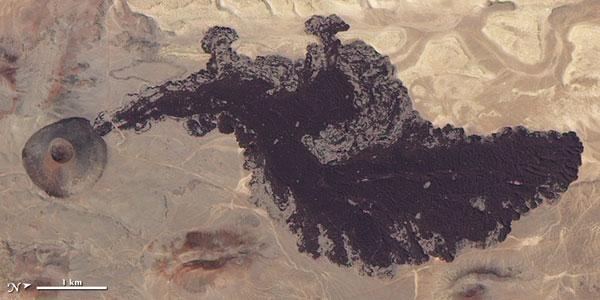
Basalt Lava Flow Forms Paisley Shape

A paisley-shaped flow of rock formed from lava flows points to its source, SP Crater, a cinder cone volcano in San Francisco Volcanic Field.
The San Francisco Volcanic Field isn't near the city in California, instead it lies in northern Arizona, covering an area of about 1,800 square miles (4,700 square kilometers). The field is made up of volcanoes and lava fields, including SP Crater.
Cinder cone volcanoes are conical structures made up of volcanic fragments, often glassy rocks containing bubbles of trapped gas. Cinder cones often form around or downwind from volcanic vents. When lava erupts from these structures, it frequently flows out of breaches on the side, and that appears to be the case at SP Crater.
Like most volcanoes in this field, SP Crater is a basalt cinder cone. Basalt has low resistance to flow, so basalt lava flows tend to travel fairly far from the eruption source.
The hardened lava flow to the north of SP Crater (to the right in this image, taken by NASA's Earth Observing-1 satellite) extends some 4 miles (6 kilometers) from the cinder cone, and is about 100 feet (30 meters) thick. Different dating techniques have placed the age of this lava between 4,000 and 71,000 years old, according to a NASA statement.
According to the U.S. Geological Survey, more than 600 volcanoes occur in the San Francisco Volcanic Field, and they have erupted at various times over the past 6 million years. Although ancient by human standards, these volcanoes are in fact geologically young.
Sign up for the Live Science daily newsletter now
Get the world’s most fascinating discoveries delivered straight to your inbox.











